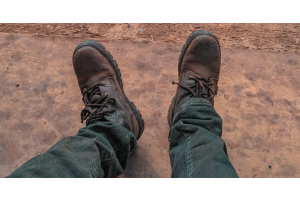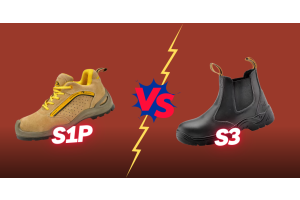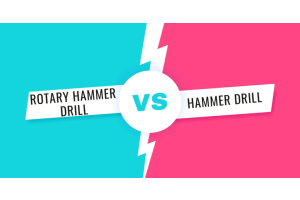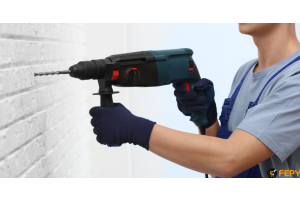7 Best Cordless Hammer Drills for Concrete

Drilling into concrete requires a specific set of tools and techniques. When it comes to choosing the right tools for the job, the importance of selecting the correct hammer drill and drill bit cannot be overstated. Whether you're a homeowner looking to do some DIY work or a professional contractor, selecting the right drill and bit can make all the difference in your project's success.
This article will provide an overview of the best hammer drills and drill bits for concrete, along with tips and techniques for drilling into concrete safely and efficiently. We'll explore the differences between a hammer drill and a rotary hammer, discuss the factors to consider when shopping for a cordless hammer drill, and review some of the best drills on the market. So, if you're planning on drilling into concrete soon, read on to find out everything you need to know to get the job done right.
How to Drill into Concrete
Drilling into concrete requires specific techniques that differ from drilling into other materials like wood or metal. Here's a step-by-step guide on drilling into concrete:
- Choose the Right Drill Bit Size: The first thing you need to do when drilling into concrete is to choose the correct drill bit size. Drill bits come in various sizes, and you need to select one that matches the diameter of the hole you want to create.
- Mark the Spot: Before you start drilling, mark the spot where you want to drill the hole using a pencil or marker. Make sure the mark is visible and easy to follow.
- Put on Safety Gear: When drilling into concrete, make sure to wear safety gear, including safety glasses, ear protection, and a dust mask.
- Set the Drill to Hammer Mode: Most drills have a hammer mode that is specifically designed for drilling into concrete. Set your drill to hammer mode before you start drilling.
- Apply Steady Pressure: Start drilling into the concrete at a slow speed, applying steady pressure on the drill. If the drill starts to slow down or stall, reduce the pressure and speed.
- Clear the Dust: As you drill into the concrete, it will create a lot of dust. Make sure to clear the dust away regularly using a vacuum or dustpan and brush.
Check the Depth: Periodically check the depth of the hole you're drilling to ensure it's the correct depth.
Best Drills for Concrete
When it comes to drilling into concrete, not all drills are created equal. Some are designed specifically for drilling into hard materials like concrete, while others may not have the power or durability required. Here's a comparison of corded vs. cordless drills for concrete:
- Corded Drills: Corded drills are typically more powerful than cordless drills and are better suited for heavy-duty applications. They are more durable and long-lasting. However, corded concrete drills are less portable and can be more challenging to maneuver in tight spaces.
- Cordless Drills: Cordless drills are more portable and easier to maneuver, making them ideal for DIY projects or smaller jobs. They're also more convenient as you don't have to worry about cords and outlets. However, they tend to be less powerful and may not be suitable for heavy-duty applications.
When choosing a concrete drill, consider the type of job you'll be doing and the amount of power you'll need. It's also essential to consider the drill's durability, warranty, and cost.
Hammer Drill or Rotary Hammer?
When choosing between a hammer drill or rotary hammer, consider the size of the job, the size of the holes you need to drill, and the material you're drilling into. If you're only drilling small to medium-sized holes, a hammer drill will likely be sufficient. However, if you're drilling larger holes or making deeper cuts, a rotary hammer may be the better choice.
- Hammer Drill: A hammer drill uses a special mechanism that delivers a hammering action while the drill bit rotates. This action helps to break up the concrete, making it easier to drill through. Hammer drills are suitable for drilling small to medium-sized holes in concrete and other hard materials.
Rotary Hammer: A rotary hammer uses a piston mechanism that delivers a more powerful hammering action than a hammer drill. This action is ideal for drilling larger holes or making deeper cuts in concrete. Rotary hammers are typically more expensive than hammer drills, but they're also more powerful and can handle more heavy-duty applications.
Choosing Cordless Hammer Drills for Concrete
When shopping for a cordless hammer drill for concrete, there are several factors to consider:
- Power: Look for a drill with a high voltage battery for maximum power. The higher the voltage, the more powerful the drill will be.
- Battery Life: Make sure to choose a drill with a long battery life. The last thing you want is to run out of power in the middle of a job.
- Durability: Look for a drill that is durable and can withstand heavy use. Consider the materials used to construct the drill and read reviews to see how it holds up over time.
- Chuck Size: Consider the size of the chuck, as this will determine the size of the drill bits you can use.
Comfort: Choose a drill that is comfortable to hold and use, as you'll be using it for extended periods.
Tips for Drilling into Concrete
Here are some additional tips for drilling into concrete:
- Use the Right Drill Bit: Use a drill bit specifically designed for drilling into concrete. These bits are made from a harder material than regular drill bits and can handle the tough material.
- Apply Lubrication: Use a lubricant, such as oil or water, to reduce friction and heat when drilling into concrete.
- Keep the Drill Bit Cool: Periodically remove the drill bit from the hole and cool it down to prevent it from overheating.
- Be Patient: Drilling into concrete can take time, so be patient and take breaks if needed.
- Use the Right Speed: Make sure to use the right speed for the type of material you're drilling into. Using the wrong speed can damage the drill bit or the material.
Best Cordless Hammer Drills for Concrete
The best drill machine for concrete walls is usually a cordless hammer drill. When choosing a cordless hammer drill for concrete, consider your budget, the features you need, and the type of job you'll be doing. Choose a concrete drill that is powerful, durable, and comfortable to use. The 7 best Cordless Hammer Drills are:
- DeWalt DCD996B: This drill boasts a powerful brushless motor and can deliver up to 2,250 RPM.
- Milwaukee M18 Fuel: This drill has a brushless motor and can deliver up to 1,200 pounds of torque.
- Makita XPH07Z: This drill has a four-pole motor and can deliver up to 1,090 pounds of torque.
- Bosch GBH18V-20N: This drill features a brushless motor and can deliver up to 0-5,850 BPM.
- Ryobi P1813: This drill has a brushless motor and can deliver up to 750 pounds of torque.
- Hitachi DV18DBFL2S: This drill has a brushless motor and can deliver up to 1,205 pounds of torque.
- Black+Decker LD120VA: This drill is a budget-friendly option and is ideal for DIY projects or smaller jobs.
Frequently Asked Questions about Drilling into Concrete
How do I choose a good hammer drill?
Choosing a good hammer drill requires consideration of several factors such as the type of job, the material you'll be drilling into, and the features you need. Some important factors to consider when choosing a hammer drill include power, speed, chuck size, durability, and ease of use. It's also essential to consider the brand's reputation, warranty, and cost. Look for reviews and recommendations from other users to ensure that you're selecting a high-quality hammer drill that can handle the job.
What is important before drilling into concrete?
Before drilling into concrete, it's crucial to ensure that the surface is clean and free of any debris. You should also make sure that you have the correct drill bit for the job and that it's in good condition. Safety gear such as safety glasses, ear protection, and a dust mask should also be worn to protect yourself from dust and debris. Make sure to also check for any pipes, wires, or other obstacles that may be hidden behind the concrete surface and avoid drilling near these areas.
What is the easiest way to drill into concrete?
The easiest way to drill into concrete is to use a hammer drill with a carbide-tipped drill bit specifically designed for concrete. Set the drill to hammer mode, apply steady pressure, and make sure to clear away any dust or debris regularly. Using a lubricant, such as oil or water, can also help reduce friction and make the drilling process smoother.
Who makes the best concrete hammer drill?
Several brands make high-quality concrete hammer drills suitable for drilling. Some of the most popular brands include DeWalt, Bosch, Makita, Milwaukee, and Hitachi. When choosing a brand, consider their reputation for quality and durability, as well as their warranty and cost.
Will a cordless hammer drill work on concrete?
Yes, a cordless hammer drill can work on concrete, but it's important to choose a drill that is powerful enough and has a long battery life. Cordless drills are more portable and convenient than corded drills, but they may not be as powerful or suitable for heavy-duty applications.
Which drill is best for drilling concrete?
Both hammer drills and rotary hammers are suitable for drilling into concrete, but the type of drill you choose will depend on the size of the job and the material you're drilling into. Hammer drills are suitable for drilling small to medium-sized holes, while rotary hammers are ideal for drilling larger holes or making deeper cuts.
Do you hammer drill concrete fast or slow?
When drilling into concrete, it's important to maintain a steady pace and apply steady pressure. Start drilling at a slow speed and gradually increase the speed as needed. Avoid drilling too quickly or applying too much pressure, as this can damage the drill bit or the material.
What is the best drill bit for very hard concrete?
The best drill bit for very hard concrete or the best drill for concrete walls is a carbide-tipped drill bit. These bits are designed to handle tough materials and can withstand the hardness of very hard concrete.
When should you not use a hammer drill?
You should not use a hammer drill on soft materials such as wood or plaster, as this can damage the material. Additionally, you should avoid using a hammer drill near pipes or wires, as this can cause damage or create a safety hazard.
What is the best way to drill through thick concrete?
The best drill for concrete walls is to use a rotary hammer with a carbide-tipped drill bit. These tools are designed to handle heavy-duty applications and can drill through even the thickest concrete.
Why is my concrete drill bit not going through?
There are several reasons why a drill bit may not be going through concrete. One common reason is that the drill bit is dull or worn out and needs to be replaced. Another reason may be that the drill is not powerful enough to handle the density of the concrete. It's also possible that the drill bit is not suitable for the type of concrete you're drilling into. Make sure to use a carbide-tipped drill bit designed for drilling into concrete and apply steady pressure.
What type of oil do you use for hammer drills?
When drilling into concrete with a hammer drill, it's important to use a lubricant to reduce friction and heat. Water can be used as a lubricant, but for better performance, a special lubricating oil designed for hammer drills can be used. This oil is typically made from mineral oil or synthetic oil and is designed to reduce friction and extend the life of the drill bit.
What should I look for in a cordless hammer drill?
When selecting a cordless hammer drill, consider factors such as power, battery life, durability, comfort, and chuck size. Look for a drill with a high voltage battery for maximum power and a long battery life to avoid running out of power in the middle of a job. Consider the durability of the drill and the materials used to construct it. Choose a drill that is comfortable to hold and use, with a suitable chuck size for the drill bits you'll be using.
How long should concrete dry before drilling?
It's recommended to wait at least 28 days for concrete to fully cure before drilling. Waiting this amount of time ensures that the concrete is strong enough to withstand the drilling process and prevents damage to the material.
What type of concrete drilling machine should be used in masonry?
When drilling masonry or concrete, a rotary hammer or a hammer drill is typically used. Rotary hammers are more powerful and are designed for heavy-duty applications such as drilling larger holes or making deeper cuts. Hammer drills are suitable for smaller jobs or drilling smaller holes. When selecting a concrete drilling machine, consider the type of job, the material you're drilling into, and the power you need.
What is the best concrete drill bit for reinforced concrete?
The best concrete drill bit is a diamond-tipped drill bit. These bits are designed to handle the toughness of reinforced concrete and can drill through both the concrete and the reinforcement material. They are more expensive than other types of drill bits but are necessary when drilling through reinforced concrete.
What speed do you hammer a concrete drill?
The speed at which you hammer a concrete drill depends on the size of the job and the material you're drilling into. Start drilling at a slow speed and gradually increase the speed as needed. Avoid drilling too quickly or applying too much pressure, as this can damage the drill bit or the material.
Conclusion
Drilling into concrete can be a challenging task, but with the right tools and techniques, it can be done safely and efficiently. By following the tips and techniques outlined in this article, you'll be well on your way to drilling into concrete like a pro. Remember to prioritize safety, choose the right tools for the job, and take your time to get the job done right.





